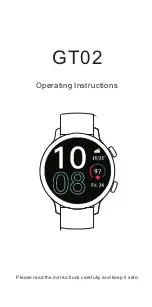
Training Status Levels
Training status shows you how your training affects your fitness level and performance. Your training status is
based on changes to your VO2 max., acute load, and HRV status over an extended time period. You can use
your training status to help plan future training and continue improving your fitness level.
No Status: The watch needs you to record multiple activities over two weeks, with VO2 max. results from
running or cycling, to determine your training status.
Detraining: You have a break in your training routine or you are training much less than usual for a week
or more. Detraining means that you are unable to maintain your fitness level. You can try increasing your
training load to see improvement.
Recovery: Your lighter training load is allowing your body to recover, which is essential during extended periods
of hard training. You can return to a higher training load when you feel ready.
Maintaining: Your current training load is enough to maintain your fitness level. To see improvement, try adding
more variety to your workouts or increasing your training volume.
Productive: Your current training load is moving your fitness level and performance in the right direction. You
should plan recovery periods into your training to maintain your fitness level.
Peaking: You are in ideal race condition. Your recently reduced training load is allowing your body to recover
and fully compensate for earlier training. You should plan ahead, since this peak state can only be maintained
for a short time.
Overreaching: Your training load is very high and counterproductive. Your body needs a rest. You should give
yourself time to recover by adding lighter training to your schedule.
Unproductive: Your training load is at a good level, but your fitness is decreasing. Try focusing on rest, nutrition,
and stress management.
Strained: There is imbalance between your recovery and training load. It is a normal result after a hard training
or major event. Your body may be struggling to recover, so you should pay attention to your overall health.
Tips for Getting Your Training Status
The training status feature depends on updated assessments of your fitness level, including at least one VO2
max. measurement per week (
About VO2 Max. Estimates, page 92
). Indoor run activities do not generate a
VO2 max. estimate in order to preserve the accuracy of your fitness level trend. You can disable VO2 max.
recording for ultra run and trail run activities if you do not want those run types to affect your VO2 max. estimate
(
Activities and App Settings, page 61
).
To get the most out of the training status feature, you can try these tips.
• At least one time per week, run or ride outdoors with a power meter, and reach a heart rate higher than 70% of
your maximum heart rate for at least 10 minutes.
After using the watch for one or two weeks, your training status should be available.
• Record all of your fitness activities on your primary training device, allowing your watch to learn about your
performance (
Syncing Activities and Performance Measurements, page 75
).
• Wear the watch consistently while you sleep, to continue generating an up-to-date HRV status. Having a valid
HRV status can help maintain a valid training status when you do not have as many activities with VO2 max.
measurements.
Acute Load
Acute load is a weighted sum of your excess post-exercise oxygen consumption (EPOC) for the last several
days. The gauge indicates whether your current load is low, optimal, high, or very high. The optimal range is
based on your individual fitness level and training history. The range adjusts as your training time and intensity
increase or decrease.
100
Appearance
Содержание DESCENT MK3 Series
Страница 1: ...DESCENT MK3SERIES Owner sManual ...
Страница 10: ......
Страница 195: ......
Страница 196: ...support garmin com GUID 9183E86B 2399 4CFC AB50 EAFC6D6ED326 v1 November 2023 ...
















































